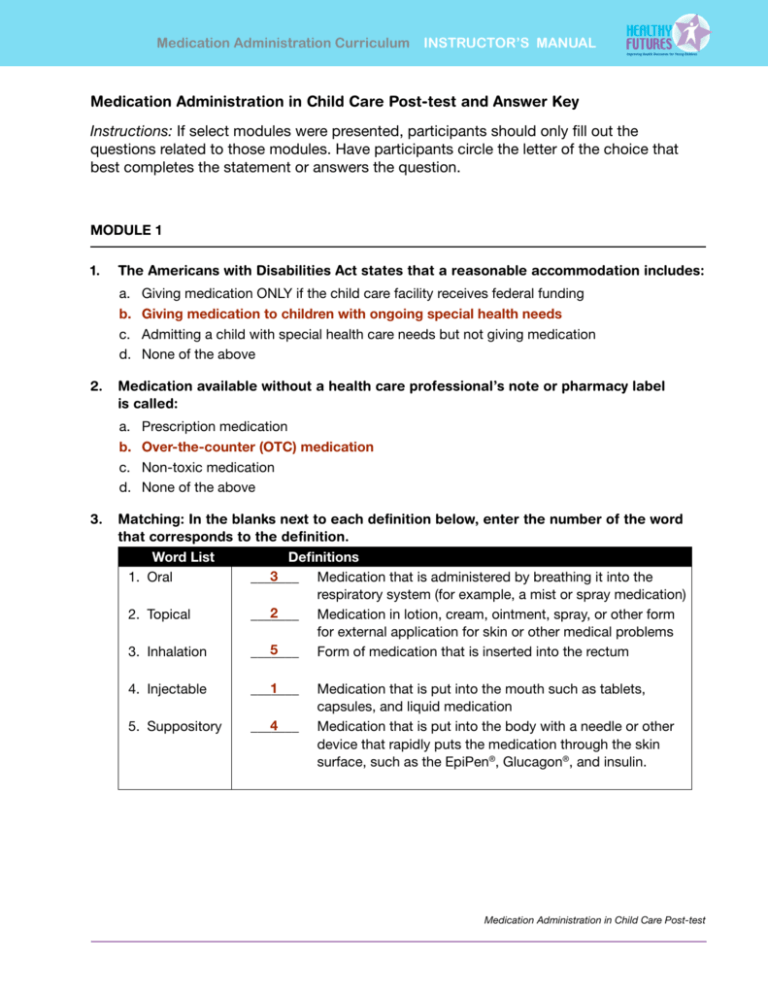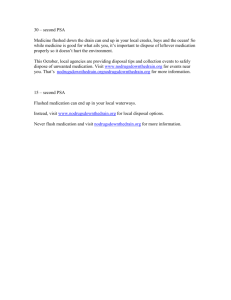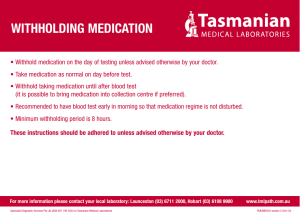Medication Administration in Child Care Post
advertisement

Medication Administration Curriculum INSTRUCTOR’S MANUAL Medication Administration in Child Care Post-test and Answer Key Instructions: If select modules were presented, participants should only fill out the questions related to those modules. Have participants circle the letter of the choice that best completes the statement or answers the question. MODULE 1 1. The Americans with Disabilities Act states that a reasonable accommodation includes: a. b. c. d. Giving medication ONLY if the child care facility receives federal funding Giving medication to children with ongoing special health needs Admitting a child with special health care needs but not giving medication None of the above 2. Medication available without a health care professional’s note or pharmacy label is called: a. b. c. d. Prescription medication Over-the-counter (OTC) medication Non-toxic medication None of the above 3. Matching: In the blanks next to each definition below, enter the number of the word that corresponds to the definition. Word List Definitions 3 1.Oral ������� Medication that is administered by breathing it into the respiratory system (for example, a mist or spray medication) 2 2.Topical ������� Medication in lotion, cream, ointment, spray, or other form for external application for skin or other medical problems 5 3.Inhalation ������� Form of medication that is inserted into the rectum 4.Injectable 5.Suppository 1 ������� Medication that is put into the mouth such as tablets, capsules, and liquid medication 4 ������� Medication that is put into the body with a needle or other device that rapidly puts the medication through the skin surface, such as the EpiPen®, Glucagon®, and insulin. Medication Administration in Child Care Post-test Medication Administration Curriculum INSTRUCTOR’S MANUAL Module 2 4. Your facility policy should include all of the following: a. b. c. d. e. Who will administer medication and who the alternate person will be What medication will be given Where and how medication will be stored Procedure for medication error or incident All of the above 5. A mother brings in some chewable tablets that she took from a bottle of medication that she says her daughter’s health care professional prescribed the day before. The mother is keeping the main supply of the medication at home. She fills out the program forms to give permission to the staff to give the medication at noon to her child. What is the most appropriate thing for the child care provider to do? a. b. c. d. Call the health care professional immediately to see if it is okay to give the medication Give the medication to the child if it looks/smells okay Refuse to give the medication Don’t know 6. When receiving a medication you should: a. Match the label with permissions and instructions b. Ask the parent/guardian about successful techniques that he has used to administer the medication c. Ask the parent/guardian about when the medication was last administered d. All of the above 7. A guardian brings you medication for her child. After receiving the medication, your next step should be to: a. b. c. d. Sort the medication for ease of delivery Log in medication and store it Administer the medication within the next 3 hours Don’t know 8. All of the following are steps in the process of receiving medications EXCEPT: a. b. c. d. Match the label with the instructions Check if container is labeled child-resistant Check expiration date Ensure that the child receives a dose that same day Medication Administration in Child Care Post-test Medication Administration Curriculum INSTRUCTOR’S MANUAL Module 3 9. Ways to tell if you have the Right child include all of the following EXCEPT: a. b. c. d. Knowing the child from your experience Asking the child if she is the name that appears on the label Having a photo of the child attached to the medication administration paperwork Having another staff member who is familiar with the child verify her identity 10. Administering the Right dose of medication involves all of the following EXCEPT: a. b. c. d. Checking the label and the permission form to see if they match. Using a measuring device Verifying the dose with the child Checking the measuring device at eye level 11. Which of the following is an example of an “as needed medication”? a.Tylenol® for fever b.Albuterol® for wheezing c. Amoxicillin for ear infection d. A and B e. All of the above 12. A child refuses to take her medication. In order to get the child to comply, you consider mixing the medication with her favorite beverage. Before doing so you should: a. Split the medication into 2 doses to ensure that the child takes her full dosage b. Check with the health care professional or pharmacist before mixing medications with food or beverages c. Give the child a small portion of the beverage prior to mixing the medication into it d. None of the above 13. A young toddler in your care is refusing to take a dose of antibiotic. You should: a. b. c. d. Mix it in the child’s bottle Hold his nose until he opens his mouth Refuse to give the child the medication Give the child the choice of what drink he wants after taking the medication Medication Administration in Child Care Post-test Medication Administration Curriculum INSTRUCTOR’S MANUAL Module 4 14. Please read the scenario and enter the information into the medication log below. Scenario: Today, you give Nick one 125 mg capsule of Depakote® sprinkles at 12:00 PM. Medication Log PAGE 3—TO BE COMPLETED BY CAREGIVER/TEACHER Name of child ______________________________________________________Weight of child_________________________ Monday Tuesday / / Wednesday Thursday Friday Medicine Date Actual time given / / / / / / / / AM ___________ AM ___________ AM ___________ AM ___________ AM ___________ PM ___________ PM ___________ PM ___________ PM ___________ PM ___________ Monday Tuesday Wednesday Thursday Friday / / Dosage/amount Route Staff signature Medicine Date Actual time given / / / / / / / / AM ___________ AM ___________ AM ___________ AM ___________ AM ___________ PM ___________ PM ___________ PM ___________ PM ___________ PM ___________ Dosage/amount Route Staff signature Describe error/problem in detail in a Medical Incident Form. Observations can be noted here. Date/time Error/problem/reaction to medication Action taken RETURNED to parent/guardian Date / DISPOSED of medicine / Caregiver/teacher ­signature Parent/guardian signature Caregiver/teacher signature Caregiver/teacher signature Witness signature / Date Medication Administration in Child Care Post-test Name of parent/guardian notified and time/date / Medication Administration Curriculum INSTRUCTOR’S MANUAL Module 5 15. Upset stomach, diarrhea, dry mouth, changes in mood, and drowsiness after taking a medication are all examples of: a. b. c. d. Effective medication Medication errors Side effects Overdose of medication 16. When calling Poison Control, you should have which of the following information available? a. b. c. d. e. The medication container The child’s current weight The child’s Emergency Contact Form All of the above None of the above 17. In which of the following situations should Poison Control be called: a. b. c. d. The child refuses to take his medication You give the wrong medication to a child You give a medication to the wrong child B and C 18. A child takes his medication in his mouth and then spits it out. What actions should be performed? a. b. c. d. e. Notify the parent/guardian Repeat the dose Fill out a medication incident report A and C All of the above 19. It is 2:00 PM and you realize that you forgot to give a dose of medication that was due at 12:00 PM. The first thing you should do is: a. b. c. d. Give the dose right away Document the missed dose and notify the parent Contact the child’s doctor Contact the pharmacy to get the pharmacist’s advice Medication Administration in Child Care Post-test





